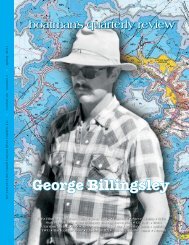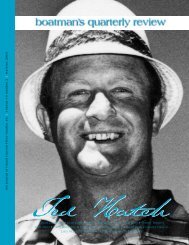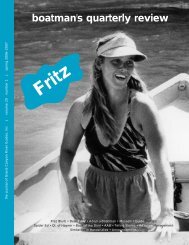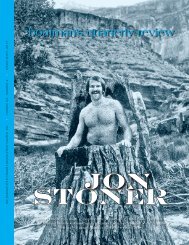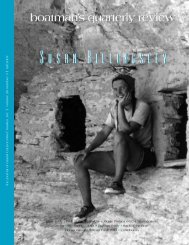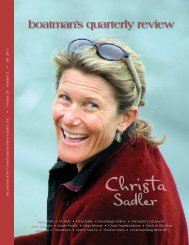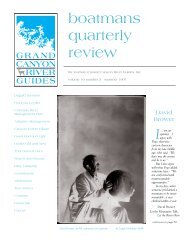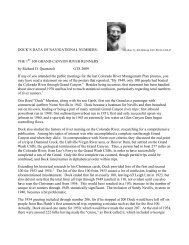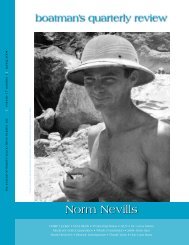boatman's quarterly review - Grand Canyon River Guides
boatman's quarterly review - Grand Canyon River Guides
boatman's quarterly review - Grand Canyon River Guides
You also want an ePaper? Increase the reach of your titles
YUMPU automatically turns print PDFs into web optimized ePapers that Google loves.
Excavation work began in May 2007 when mna and<br />
grca archeologists excavated two masonry rooms at a<br />
site below the Little Colorado <strong>River</strong>. Last September and<br />
October, crews excavated three structures exposed in<br />
arroyo cuts in a site known as Furnace Flats. At the<br />
conclusion of their work, archeologists backfilled, planted<br />
vegetation, and recontoured the areas to remove all<br />
evidence of the archeological excavation. To continue to<br />
protect the highly erosive and fragile nature of the<br />
Furnace Flats area, it remains closed to all visitation.<br />
To meet the National Park Service’s preservation<br />
mandate, backfilling, transplanting vegetation, and other<br />
stabilization measures following excavation will continue<br />
to be an integral part of all future work. Reburying a site<br />
after excavation is not a typical archeological practice,<br />
but is necessary in <strong>Grand</strong> <strong>Canyon</strong> to protect the sites<br />
from future degradation that would occur if these fragile<br />
structures were left exposed.<br />
Outreach and interpretation of the sites is a critical<br />
component of the grca and mna excavation project.<br />
Approximately 800 individuals on commercial, noncommercial,<br />
and research trips toured the excavations in<br />
2007. <strong>Grand</strong> <strong>Canyon</strong> National Park will continue to<br />
invite river trip participants to visit sites while excavation<br />
work is ongoing. Excavation trips are planned for<br />
spring and fall 2008 and 2009. Lees Ferry rangers will<br />
inform trip leaders at the launch when excavations are<br />
in progress, and a grca interpreter will provide tours.<br />
Visits during the excavations are only a small part of the<br />
anticipated interpretive and educational efforts. Grca<br />
and mna plan future publications, exhibits, and other<br />
interpretive media. Currently, a multimedia slideshow<br />
from one of the Furnace Flats excavation trips is available<br />
online at www.dawnkishphotography.com/<br />
<strong>Grand</strong>Archaeology/. An exhibit featuring the<br />
photographs of the excavations by Flagstaff photographer<br />
Dawn Kish will be in the Branniger Chase Hallway<br />
Archaeologists backfilling after excavation.<br />
Photo courtesy of Lisa Leap, NPS photo.<br />
at the Museum of Northern Arizona from March 1<br />
through July 2008. This exhibit is sponsored by <strong>Grand</strong><br />
<strong>Canyon</strong> Association, <strong>Grand</strong> <strong>Canyon</strong> National Park, and<br />
the Museum of Northern Arizona.<br />
After the completion of the project, artifacts,<br />
photographs and video documentation will be permanently<br />
curated in the <strong>Grand</strong> <strong>Canyon</strong> National Park<br />
Museum Collection. The findings will be incorporated<br />
in future exhibits and public educational efforts at grca,<br />
mna and various tribal visitor centers.<br />
Balsom concluded, “The opportunity to excavate<br />
these sites in the Colorado <strong>River</strong> corridor is very<br />
exciting, and this research will almost certainly reveal<br />
new information about the human history and prehistory<br />
of <strong>Grand</strong> <strong>Canyon</strong> We think that the educational and<br />
interpretive components of this project really show what<br />
<strong>Grand</strong> <strong>Canyon</strong> National Park is trying to achieve. We<br />
work to preserve the Park’s resources while giving opportunities<br />
to the public to experience them, whether it is<br />
via on-site tours to river trip participants while the excavations<br />
are in progress, or by planning future museum<br />
exhibits.”<br />
Allyson Mathis and Lisa Leap<br />
<strong>Grand</strong> <strong>Canyon</strong> National Park<br />
Book Review<br />
<strong>Grand</strong> Obsession: Harvey Butchart and the Exploration of<br />
<strong>Grand</strong> <strong>Canyon</strong>, by Elias Butler and Tom Myers; Puma<br />
Press; 2007; 455 pages; $19.95.<br />
You could read every book out there on the one<br />
and only <strong>Grand</strong> <strong>Canyon</strong> and you are still likely to<br />
come away empty and unable to humanly grasp the<br />
immensity or the character of that incredible and vast<br />
work of nature.<br />
One exception. Read this newest book on the <strong>Grand</strong><br />
<strong>Canyon</strong> and Harvey Butchart (1907–2002)—a man<br />
whose love of the canyon meant he hiked, climbed,<br />
floated and bushwhacked some 12,000 pioneering miles<br />
below the rim during 42 years. Then, through accounts of<br />
his adventures, you may be able to at least temporarily<br />
clutch that vast landscape in your mind.<br />
This book required fifteen years of research and is<br />
woven into a masterful work about the human side of the<br />
<strong>Grand</strong> <strong>Canyon</strong>, as well as some physical features.<br />
There’s a lot written about the Colorado <strong>River</strong> exploration<br />
of the <strong>Grand</strong> <strong>Canyon</strong>, but this new book focuses<br />
on the hiking and climbing aspect of it. And who better<br />
to pinpoint than Butchart, who is believed to have hiked<br />
more in the canyon than any other known person.<br />
boatman’s <strong>quarterly</strong> <strong>review</strong> page 9




